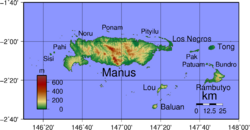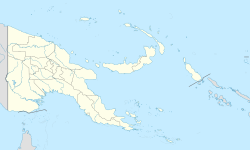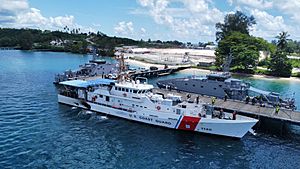Manus Island facts for kids
Manus Island is a large island in Papua New Guinea, a country in the Pacific Ocean. It is the biggest island in a group called the Admiralty Islands. Manus Island is the fifth-largest island in Papua New Guinea. It covers about 2,100 square kilometers (810 square miles) and is roughly 100 km (62 miles) long and 30 km (19 miles) wide.
The island is covered with thick, wild jungles, which are like a warm, wet tropical rain forest. Its highest point is Mount Dremsel, which is 718 meters (2,356 feet) tall. Manus Island was formed by volcanoes and likely rose from the ocean about 8 to 10 million years ago. Its ground is made of volcanic rock or uplifted coral limestone.
Lorengau is the main town and capital of Manus Province, located on the island. Momote Airport, which serves Manus Province, is on a nearby island called Los Negros Island. A bridge connects Los Negros Island to Manus Island and Lorengau. In 2000, the whole Manus Province had a population of 50,321 people. People on the island speak different Manus languages, which are part of the Austronesian language family.
Manus Island is home to the emerald green snail. Its beautiful shells were once collected and sold to make jewelry. This still happens, but less often now. The snail is a threatened species, so selling its shells is against the law in many places.
Contents
History of Manus Island
The first time Europeans saw Manus Island was on August 15, 1528. A Spanish explorer named Álvaro de Saavedra Cerón was on his ship Florida. He was trying to sail back to New Spain (which is now Mexico) from the Maluku Islands. Saavedra sailed around Manus Island and might have landed on a small island nearby called Murai. People lived on Murai, and some came out in canoes. They attacked with bows and arrows. The Spanish captured three of these men but returned them to the island the next year. Manus Island was then called Urays la Grande, meaning "Big Urays," probably named after Murai.
World War II on Manus Island
During World War II, Australian soldiers had an observation post on Manus Island. They also helped the local people with medical care. The Japanese first bombed Manus on January 25, 1942, targeting the radio tower.
On April 8, 1942, Japanese ships entered Lorengau harbor. Hundreds of Japanese soldiers landed on the island, which was controlled by Australia at the time. The Australian soldiers were greatly outnumbered. They went into the jungle and fought a guerrilla campaign. Later in 1942, Japan built a military base on Manus Island. They forced prisoners of war, including Sikh soldiers, to work there.
United States forces attacked the island in February and March 1944 as part of the Admiralty Islands campaign. The Allied forces built a large naval base at Seeadler Harbor on the island. This base, called Manus Naval Base, later helped the British Pacific Fleet. On November 10, 1944, a ship carrying ammunition, the USS Mount Hood, exploded in Seeadler Harbor. Many US Navy sailors lost their lives.
After the war, in 1950–51, the Australian government held the last trials for Japanese war crimes on the island. One important case was against Takuma Nishimura. He had already been found guilty by a British court for his role in the Sook Ching massacre in Singapore. He was sentenced to life in prison. However, Australian military police stopped him in Hong Kong. Evidence showed that Nishimura had ordered the shooting of wounded Australian and Indian soldiers at Parit Sulong. He was found guilty in this trial and was hanged on June 11, 1951.
An American anthropologist named Margaret Mead lived on Manus Island before and after the war. She wrote detailed books about her experiences, like Growing up in New Guinea and New Lives for Old.
Immigration Processing Centre
From 2001 to 2004, and again from 2012, people seeking asylum were housed on Los Negros Island, near Manus Island.
Australia set up the Manus Regional Processing Centre in 2001. This was part of its "Pacific Solution" policy for people arriving by boat without permission. In August 2012, the Australian government decided to restart this program. Asylum-seekers began to be sent to Manus Island again in November 2012.
On April 26, 2016, the Supreme Court of Papua New Guinea ruled that holding asylum seekers on Manus Island was against the law. Papua New Guinea's Prime Minister, Peter O'Neill, then announced that the center would close. By November 23, 2017, all remaining men were moved to new places like the East Lorengau Refugee Transit Centre.
In late 2019, the remaining asylum seekers were moved to Port Moresby. At the request of the Papua New Guinea government, Australia ended its contracts for the center's services on November 30, 2019.
In 2018, Australia and Papua New Guinea talked about letting the Royal Australian Navy and US Navy use port facilities on Manus Island. Australia and the United States planned to help make Lombrum Naval Base bigger. This would allow Australian naval ships to use the facilities there. Manus Island is very important because it has a deep-water port close to major shipping routes. The Royal Australian Navy had a base on Manus Island from the 1950s until it was given to the Papua New Guinea Defence Force in 1974.
Interstellar Meteor
In April 2022, scientists confirmed something amazing. A meteor that fell to Earth in 2014, called CNEOS 2014-01-08, was the first known object to come from outside our solar system! Some pieces of this meteor landed in the ocean off the coast of Manus Island. Scientists are hoping they might be able to find and study these pieces.
See also
 In Spanish: Isla Manus para niños
In Spanish: Isla Manus para niños
- Admiralty Islands languages
- Manus languages




